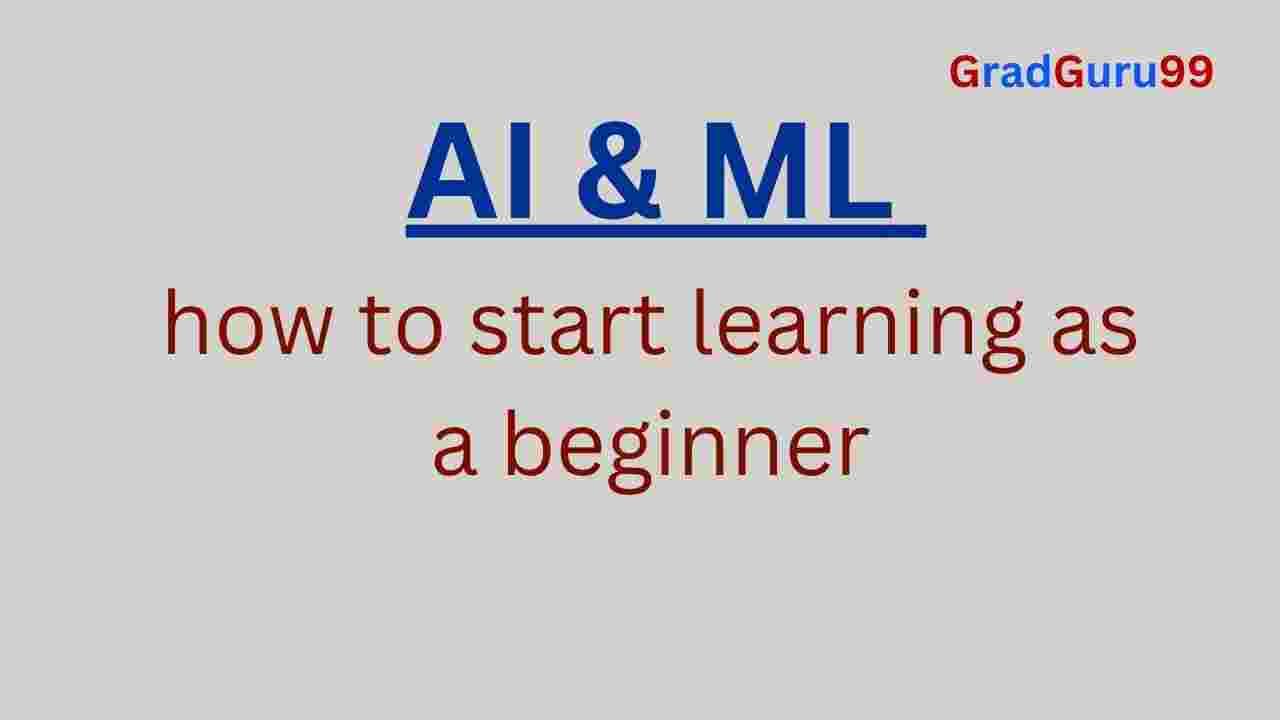How to start learning AI and ML as a beginner – a step-by-step guide
Abstract: Artificial Intelligence (AI) and Machine Learning (ML) are revolutionizing industries, and the demand for skilled professionals is booming. This guide empowers aspiring IT professionals with a clear roadmap to embark on their AI/ML learning adventure. It breaks down the process into manageable steps, covering foundational concepts, essential tools and languages, and practical project implementation.
Introduction:
The world is witnessing an AI revolution, with intelligent machines transforming everything from healthcare diagnostics to personalized recommendations. As an IT professional, staying ahead of the curve requires embracing AI and ML. This guide provides a structured approach for beginners to navigate this exciting field.
Definitions:
- Artificial Intelligence (AI): The ability of machines to mimic human cognitive functions like learning and problem-solving.
- Machine Learning (ML): A subfield of AI that enables machines to learn from data without explicit programming.
Examples of AI and ML in Action:
| Domain | Application | Description |
|---|---|---|
| Image Recognition | Facial recognition software | Automatically identifies and verifies individuals in photos and videos. |
| Fraud Detection | Anomaly detection in financial transactions | Identifies suspicious activity patterns to prevent fraudulent transactions. |
| Recommendation Systems | Product recommendations on e-commerce platforms | Analyzes user behavior and purchase history to suggest relevant products. |
Step-by-Step Guide:
| Milestone | Description | Resources |
|---|---|---|
| 1. Grasp the Fundamentals | Understand the core concepts of AI and ML, including different AI branches and various ML algorithms (supervised, unsupervised, reinforcement). | * Online courses: Platform 1: https://www.coursera.org/, Platform 2: https://www.edx.org/ * Books: “Artificial Intelligence: A Modern Approach” by Stuart Russell and Peter Norvig |
| 2. Master a Programming Language | Python is the go-to language for AI/ML due to its readability and extensive libraries. Learn syntax, data structures, and control flow mechanisms. | * Online tutorials: Platform 3: https://www.w3schools.com/python/, Platform 4: https://www.python.org/doc/ * Books: “Automate the Boring Stuff with Python” by Al Sweigart |
| 3. Build Your Math and Statistics Foundation | Brush up on concepts like linear algebra, calculus, and probability, as they form the backbone of ML algorithms. | * Online courses: Khan Academy (https://www.khanacademy.org/), MIT OpenCourseware (https://ocw.mit.edu/) * Textbooks: “Introduction to Probability” by Dimitri P. Bertsekas and John N. Tsitsiklis |
| 4. Explore Machine Learning Libraries | Libraries like scikit-learn (Python) provide pre-built implementations of popular ML algorithms. Learn how to use them for data manipulation, model training, and evaluation. | * Scikit-learn documentation: https://scikit-learn.org/ * Tutorials: Platform 5: https://developers.google.com/machine-learning/crash-course |
| 5. Dive into Deep Learning (Optional) | Deep learning, a subfield of ML, uses artificial neural networks for complex tasks like image and speech recognition. | * Online courses: Deeplearning.AI by Andrew Ng (https://www.deeplearning.ai/) * Books: “Hands-On Machine Learning with Scikit-Learn, Keras & TensorFlow” by Aurélien Géron |
| 6. Work on Hands-on Projects | Solidify your learning by tackling practical projects. Start with beginner-friendly projects like building a spam filter or movie recommender system. Gradually progress to more complex tasks. | * Kaggle Competitions (https://www.kaggle.com/) * OpenAI Gym (https://www.gymlibrary.dev/) |
Tools and Languages:
- Programming Languages: Python (primary), R (for statistical analysis)
- Libraries: scikit-learn (Python), TensorFlow (deep learning), PyTorch (deep learning)
- Frameworks: Keras (high-level deep learning API)
- Cloud Platforms: Google Cloud AI Platform, Amazon Web Services (AWS) SageMaker, Microsoft Azure Machine Learning
Benefits of Learning AI and ML:
- Increased marketability and career opportunities
- Ability to solve complex problems with data-driven solutions
- Enhanced understanding of automation and intelligent systems
Conclusion:
The journey into AI and ML is an enriching experience. By following this roadmap, setting achievable milestones, and continuously practicing, aspiring IT professionals can equip themselves with the necessary skills to thrive in this ever-evolving field.
References:
Here’s the reference section incorporating suggestions for online courses and books:
References:
- Books:
- “Artificial Intelligence: A Modern Approach” by Stuart Russell and Peter Norvig
- “Automate the Boring Stuff with Python” by Al Sweigart
- “Introduction to Probability” by Dimitri P. Bertsekas and John N. Tsitsiklis
- “Hands-On Machine Learning with Scikit-Learn, Keras & TensorFlow” by Aurélien Géron
- Online Courses:
- Platform 1: Coursera: https://www.coursera.org/
- Courses to consider: “Machine Learning” by Andrew Ng, “Introduction to Deep Learning” by deeplearning.ai specialization
- Platform 2: EdX: https://www.edx.org/
- Courses to consider: “Introduction to Artificial Intelligence” by MIT, “The Micromaster Program in Artificial Intelligence” by Georgia Institute of Technology
- Platform 3: W3Schools Python Tutorial: https://www.w3schools.com/python/
- Platform 4: Python Documentation: https://www.python.org/doc/
- Khan Academy (https://www.khanacademy.org/) (for brushing up on math and statistics)
- MIT OpenCourseware (https://ocw.mit.edu/) (for brushing up on math and statistics)
- Platform 5: Google’s Machine Learning Crash Course: https://developers.google.com/machine-learning/crash-course
- Deeplearning.AI by Andrew Ng (https://www.deeplearning.ai/) (for deep learning)
- Platform 1: Coursera: https://www.coursera.org/


